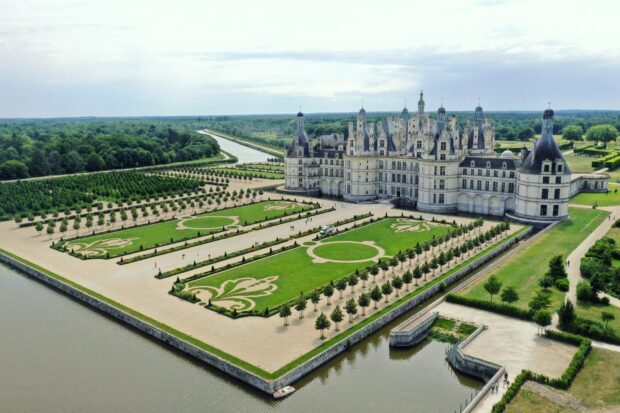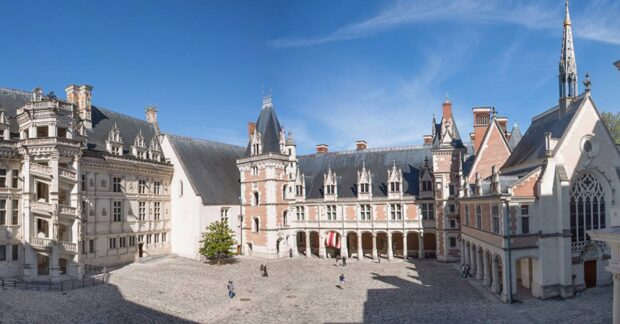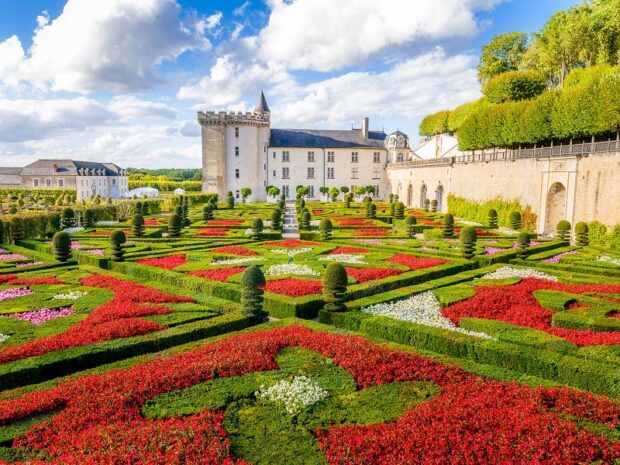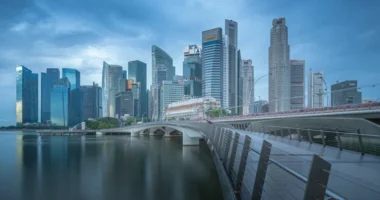Immerse yourself in a region that’s brimming with ancient history, alluring architecture, and evocative landscapes: the Loire Valley. In this region, eight distinctive castles—each with its own fascinating narrative and artistic splendor—await your discovery.
Join us on this engaging tour as we explore the magical castles scattered through the valley. The verdant French countryside has always drawn the attention of tourists because of its combination of nature, history, and man-made marvels. We explore the illustrious legacy left by the lords and ladies of the Loire that can be toured today.
Château de Chambord

The first castle on your Loire Valley Tour has to be this. Reflecting the grandeur of the French Renaissance, the Château de Chambord proudly stands as an audacious architectural masterpiece. Envisioned by King Francis I as a grand hunting lodge, this colossal structure sprawls across a vast wilderness. Its intricate facade, dominated by symmetrical towers and intricate sculptural motifs, is a testament to the ostentatious taste of French nobility during the 16th century.
Famed for its harmonious marriage of traditional French Medieval forms with Italian Classical architecture, Chambord exudes a certain allure that transcends time. Of particular interest is the double-helix staircase, inspired by none other than the artistic genius Leonardo da Vinci, where two independent staircases wind around without ever meeting—an embodiment of architectural marvel and enigma.
Château de Chenonceau
Straddling the serene waters of the Cher River, the Château de Chenonceau is an enchanting sight to behold. The elegant bridge-like gallery, reflecting on the river’s calm surface, paints a fairy-tale scene that sparks the imagination. Its construction, initiated by Thomas Bohier in the early 16th century, was completed by his wife Katherine Briçonnet, beginning Chenonceau’s long association with influential women.
Remarkably, the castle’s history is deeply intertwined with the legacies of the women who owned, inhabited, and protected it. Hence, it’s often called “Château des Dames.” Diane de Poitiers and Catherine de Medici, two of its most influential inhabitants, left their distinctive marks—Diane with the exquisite gardens and Catherine with the grand gallery over the river. The harmonious juxtaposition of nature’s bounty with architectural elegance creates a mesmerizing tapestry that evokes an emotional resonance.
Château de Amboise
Regally perched atop a hill, the Château de Amboise overlooks the quaint town of Amboise. Its imposing silhouette, composed of sturdy towers and formidable battlements, reflects its original purpose as a strategic stronghold during the Middle Ages. But beyond its austere exterior, the château holds a treasure trove of French history and artistry.
The grandeur of the château extends to its illustrious past. It served as a residence for several French kings, earning it a reputation as a nucleus of power and influence. The iconic artist and inventor, Leonardo da Vinci, even spent his last years here, leaving an indelible imprint on its design and aura. His tomb lies in the château’s chapel, imbuing the structure with an added layer of historical significance.
Château de Blois

Steeped in intrigue, the Château de Blois is a stunning tableau of architectural evolution. Its composition, a medley of classic, gothic, renaissance, and baroque elements, charts the changing aesthetic sensibilities spanning four centuries. The château’s varying styles, coalescing into a harmonious blend, tell a compelling narrative of France’s political and cultural journey.
A tour of the château unveils richly adorned rooms, regal fireplaces, and stately staircases, each bearing the imprints of the kings and queens who resided here. The château served as a theatre for royal drama, including power struggles and passionate romances. Walking through its corridors feels akin to stepping into a historical novel, brought alive by vivid frescoes and intricate carvings.
Château de Cheverny
Renowned for its meticulously preserved interiors, the Château de Cheverny offers a unique window into the noble life of the 17th century. Unlike other castles, Cheverny was built within a relatively short period, resulting in a harmonious, elegant design that embodies the classical Louis XIII style. The estate has been the property of the same family for more than six centuries, maintaining an aura of lived-in luxury.
The castle’s grand rooms are still adorned with original decor, from stunning tapestries and ornate furniture to an exquisite collection of objets d’art. The charm of Cheverny extends to the lush parkland surrounding it, where the tradition of hunting with hounds continues, echoing the pastimes of the aristocracy. The estate even inspired the fictional Marlinspike Hall in Hergé’s famous Tintin comics, further bolstering its cultural significance.
Château de Azay-le-Rideau
Nestled in the heart of Indre Valley, the Château de Azay-le-Rideau emerges as a shimmering reflection on the tranquil waters that surround it. Hailed as a masterpiece of French Renaissance architecture, this enchanting edifice, built on an island, paints a dreamy picture with its elegant turrets and ornate sculptures.
Though it may not boast the size of other Loire castles, Azay-le-Rideau compensates with its captivating beauty and refinement. Its façade, adorned with Italian and oriental influences, radiates under the soft sunlight. The manicured gardens, adorned with exotic trees and a tranquil water mirror, lend an idyllic backdrop to this architectural gem, making it a cherished destination for art and nature lovers alike.
Château de Villandry
The last of the great castles built during the Renaissance along the Loire River, the Château de Villandry is perhaps best known for its spectacular gardens. The expansive estate, spreading across three terraces, features a water garden, ornamental flower gardens, and impressive vegetable plots—all arranged in intricate geometric patterns, representing the pinnacle of Renaissance formal garden design.
Yet, Villandry is not just about its outdoor splendor. Within its walls, the castle narrates a compelling history. Dr. Joachim Carvallo, who purchased and restored Villandry in the early 20th century, is responsible for the gardens’ current allure. It is this harmonious fusion of history, architecture, and horticultural artistry that positions Villandry as a must-visit destination in the Loire Valley.
Wrapping Up
To journey through the Loire Valley is to step into the pages of a living history book, where each castle unravels its own tale of passion, power, artistry, and intrigue. As we wrap up our explorative sojourn, these stone-clad sentinels continue to stand in stoic silence, their stories echoing in the breeze that sweeps across the picturesque landscapes of the Loire. These eight captivating châteaus, embodying the heart and soul of the region, beckon to both history buffs and dreamers, promising an immersive experience that lingers long after the visit. So, pack your spirit of adventure and set forth to discover the enchanting realm of the Loire Valley castles.





